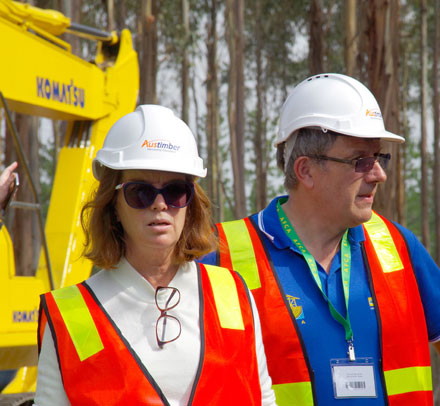
Australia’s total sawlog harvest has reached a record high of 33.1 million cubic metres, a rise of 10%, with gross value also a record $2.6 billion, up 13%, latest figures show. Source: Philip Hopkins for Timberbiz
Exports also increased by 11% to $3.5 billion, driven by woodchips, according to the report by Australian Bureau of Agricultural and Resource Economics and Sciences (ABARES) for the 2016-17 year. All comparisons in the 2017 September and December quarters report are with 2015-16.
The volume of logs from native forest production forests rose by 4% to 4.3 million cubic metres. However, output in the native forest sector has more than halved in the past decade from 8.8 million cubic metres in 2006-07.
Other key features of the report are:
- Forest products manufacturing and services were worth $23.7 billion in 2015-16.
- Record hardwood and softwood commercial plantation harvest of 29m3, with plantations now making up 87 per cent of total log output, up 19% over the decade.
- Commercial hardwood plantation volumes rose by 16% to 11.4m3, having more than doubled since 2012-13.
- The value of hardwood plantation logs rose by 14% to $807 million (mill door price), with 96% pulp log for woodchip exports. Saw and veneer logs and other products made up the remaining 4%.
- Total wood products trade rose by 1% to a record $8.7 billion in 2016-17. With imports decreasing by 4% to $5.3 billion, the trade deficit was $1.8 billion.
The Assistant Minister for Agriculture and Water Resources, Senator Anne Ruston, said more and more, forest products industries were boosting the well-being of regional towns and communities.
“These statistics reflect confidence in the industry and confidence from our key export markets,” she said.
However, Australia’s peak forestry body said the positive news should not distract from the long-term issues facing the industry.
“We need major policy changes and action from government to ensure the future viability of the full value chain,” said the chief executive of the Australian Forest Products Association, Ross Hampton.
“We need more trees in the ground to meet the increasing demand for forest products in decades to come.”
Mr Hampton said the AFPA had been calling for 400,000 new hectares of tree plantings – 300,000 of new plantations and 100,000 of suitable farm forestry.
The latest plantation update showed a reduction in the plantation estate. Without more trees in the ground,
“inevitably Australia will be forced to import more and more timber products.
“Our local timber industry, including timber processing and value-added manufacturing, will suffer,” he said.
The Turnbull Government has allocated $20 million in the federal budget for its National Forestry Industry Plan, which will be released later this year.
The ABARES report said total log harvest from native forest comprised 95% hardwood and 5% softwood (cypress pine).
This total included 50% saw and veneer logs for the high quality structural and appearance-grade market, while 46% was pulp logs for woodchip exports and domestic paper production.
The report said softwood plantation logs reached a record 17.5m3 in 2016-17, up 8%. This consisted of sawlogs (10.6m3, up 7%) and pulp logs (6.5m3, up 11%).
Most softwood logs were saw and veneer logs (61%), while softwood pulp logs – used for woodchip exports, domestic paper, paperboard and panel products – comprised 37%. Other products such as round wood, post and poles, made up the remaining 2%.
In total value, plantation softwood logs increased by 15% to $1.4 billion.
The report said the domestic production of wood products had followed varying trends over the past decade. These products include sawn wood, wood-based panels (plywood, particleboard and medium-density fibreboard), and paper and paperboard.
“More recently, domestic production volumes have been gradually increasing – sawn wood since 2011-12 and wood-based panels and paper/paperboard since 2012-13,” said the report.
For a copy of the report, visit www.agriculture.gov.au/abares/publications





